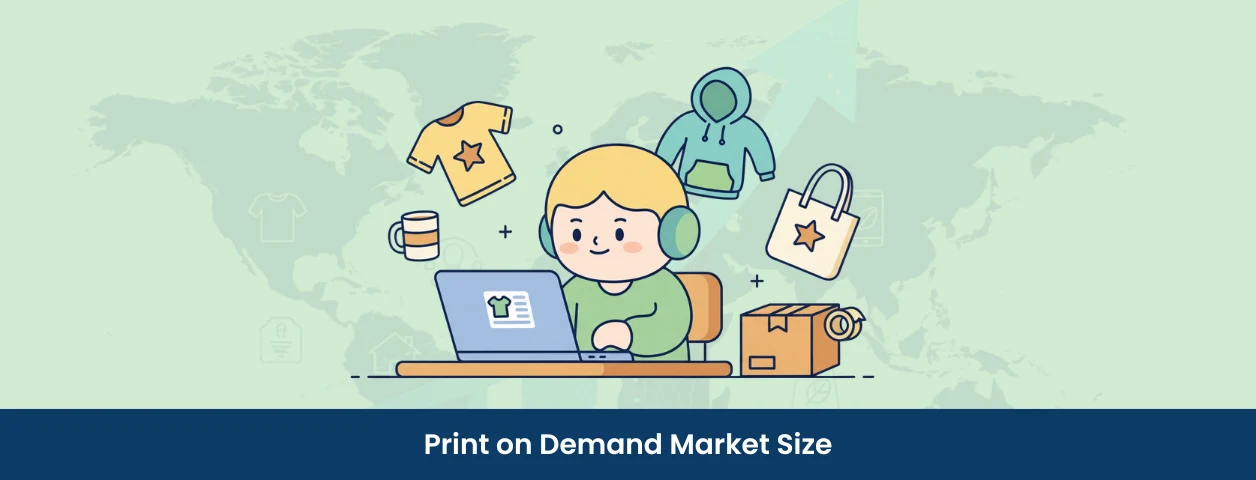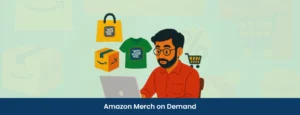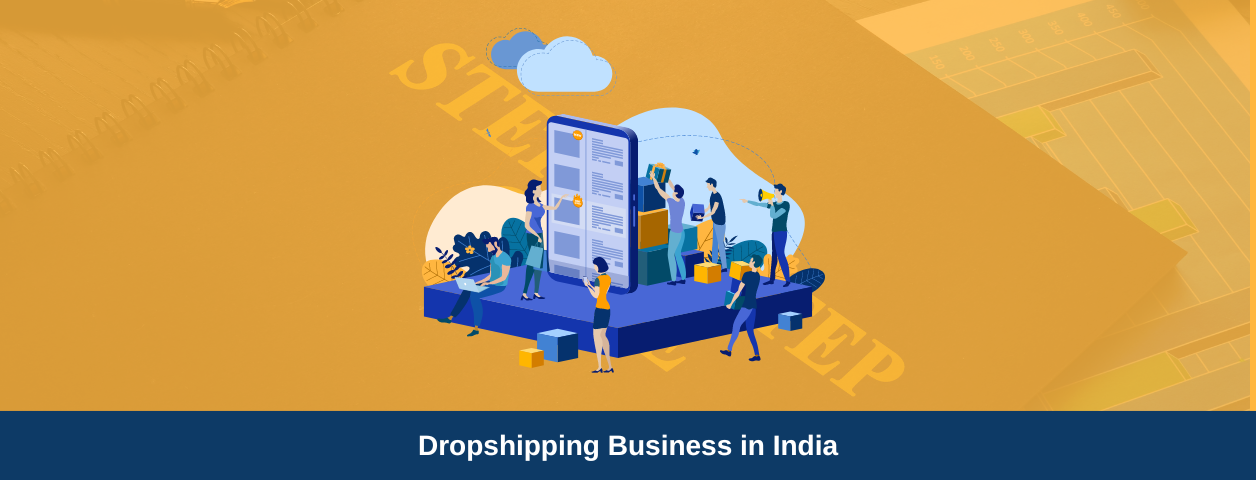Print on Demand market size has reached an all-time high, reflecting how personalisation, sustainability, and digital commerce continue to influence global retail. From independent creators to established brands, more businesses are turning to on-demand production because of its scalable, low-risk model that aligns with modern customer expectations.
According to Grand View Research, the global print on demand market size was estimated at $9-12 billion / ₹0.79–₹1.06 trillion in 2025 and is projected to grow at a Compound Annual Growth Rate (CAGR) of 23.3% from 2025 to 2033, reaching approximately $57.49 billion / ₹5.08 trillion by 2033.
Consumers increasingly prefer sustainable printed apparel, accessories, and home decor that reflect their individuality, while businesses embrace the POD (Print-on-Demand) model for its zero-inventory, low-risk operations.
With the growth of eCommerce integration and AI-based design tools, the industry has become a bigger opportunity for both creators and enterprises. This guide explores the print on demand market size, revenue, and key statistics, highlighting growth factors and regional insights for entrepreneurs and businesses looking to build their brands.
Key Takeaways:
- North America continues to lead with a share of more than 40% of global revenue, while the Asia Pacific region, led by India and China, is the fastest-growing market, driven by eCommerce growth.
- The demand for customised, sustainable products continues to drive industry growth as brands move toward made-to-order production models.
- Emerging technologies like design automation and on-demand digital textile printing are enhancing operational speed and design personalisation.
- The industry’s profitability stays strong, with sellers earning an average margin of 15-20% across categories.
- Print-on-demand’s scalability, sustainability, and low-risk entry model make it one of the most accessible business opportunities.
Print on Demand Market Size
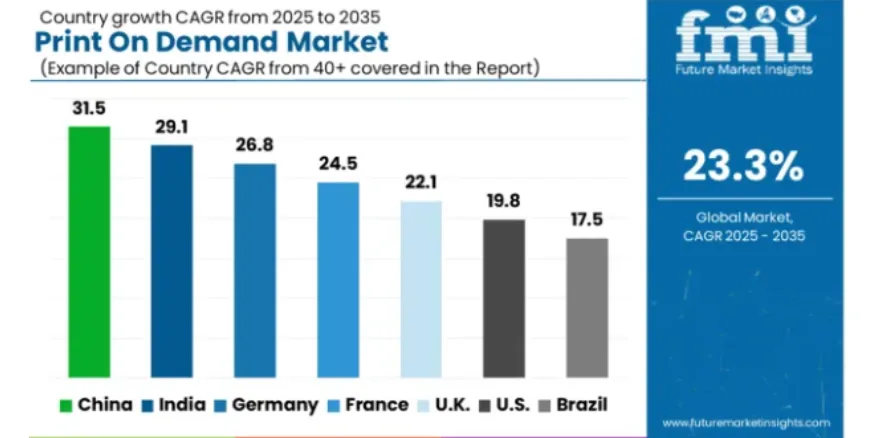
Source: Future Market Insights
The global print on demand market has emerged as a major component of the modern eCommerce landscape, driven by technological innovation, eco-conscious consumer trends, and the demand for product personalisation.
With a 23.3% CAGR, the market is projected to reach around $90 billion / ₹7.92 trillion by 2035. This rate of development is led by the software segment (54.2%), followed by the apparel segment (47.8%), according to market reports.
You can become a brand seller in 2025, because,
- With the market still under $15 billion (₹1.36 trillion), end-of-year print on demand forecasts indicate the market’s maturity and geography, helping it grow further.
- Starting a business in India’s fast-growing market is a positive way to increase your income while building an individual brand.
- Focusing not only on apparel but also on home-living products and accessories is a suitable approach in the current hybrid business trend.
- Structuring your business around the terms “print-on-demand, no inventory, customised products” remains a valid business model given these forecasts.
The rise of AI-driven design tools, API-integrated storefronts, and automated order management is further accelerating the adoption of print on demand. The market’s growth is significantly helped by digital fashion and integrated eCommerce fulfilment systems, which have made custom printing accessible to individuals and small businesses.
As the print on demand market continues to evolve, embracing technology and personalisation, it offers entrepreneurs a lifetime opportunity to build a scalable, innovative brand that meets modern customer demands with minimal risk and maximum creative freedom.
Print on Demand Revenue
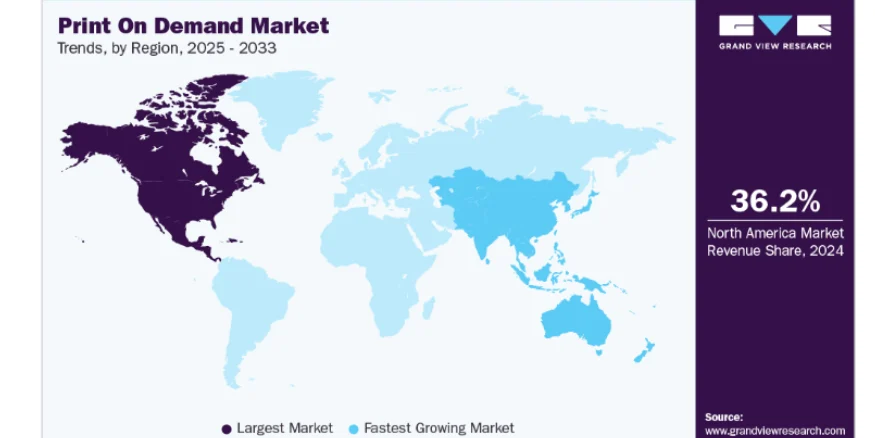
Source: Grand View Research
The print on demand industry’s revenue reflects how personalisation has shifted from a niche to a mainstream retail strategy. Launching a small, creator-led store has now evolved into a multi-billion-dollar global market with apparel, home decor, and lifestyle categories dominating online sales.
Regionally, North America accounted for 36.2% of print on demand revenue in 2024, according to the detailed research reports. As currently stated by Mordor Intelligence, this will rise to 40% in 2025 and will remain strong in the coming years. At the same time, the Asia-Pacific is expected to post the fastest growth rate beyond 2025.
Their report forecasts that figure to rise to ₹3.34 trillion by 2030, driven by growing demand for customised clothing and accessories. Reports from Precedence Research also show similar momentum of rise, estimating the market’s 2025 revenue at ₹1.14 trillion, with a projected value of ₹9.06 trillion by 2034, at a 26% CAGR.
Every other similar source report suggests only a slight difference in the numbers. But the most common finding across all the reports is that POD revenue is growing faster than in most other digital commerce models.
Following the software segments, several other segments add greater value in the print on demand revenue growth:
- Apparel remains the industry’s powerhouse, accounting for nearly 48% of total revenue, driven by demand for custom-designed t-shirts, hoodies, and sweatshirts.
- Home decor is the fastest-growing segment, with a projected 8-10% CAGR (2025-2029), according to CreteKala reports, as consumers personalise wall art, cushions, and lifestyle items for modern hybrid homes.
- Accessories and stationery, such as bags, mugs, phone cases, and notebooks, continue to expand through marketplaces, showing higher average profit margins than some types of apparel.
Emerging business models such as direct-to-consumer brands, influencer collaborations, and print on demand ventures are expected to broaden revenue streams further. The consistent demand for unique products, combined with seamless online buying experiences, ensures that print on demand will remain a leading industry for years to come.
These revenue growth insights that,
- Unlike traditional retailers, print on demand sellers spend nothing on unsold stock. Profit margins can average 15-20%, depending on fulfilment and niche selection.
- Most profitable sellers rely on timeless niches like minimal text tees, travel prints, and lifestyle quotes, which generate steady monthly orders.
- Marketplaces like Shopify and Etsy, and regional print on demand fulfilment enablers like Qikink, account for more than 60% of global print on demand revenue.
- According to Fortune Business Insights, digital textile printing reduces water consumption by 90% and energy use by 30%, directly influencing customer preference for eco-made products.
The growth in print on demand revenue depicted is not just numbers and data. It is a testament to the fact that a business that implements personalisation and sustainability has become a reliable one in the retail industry.
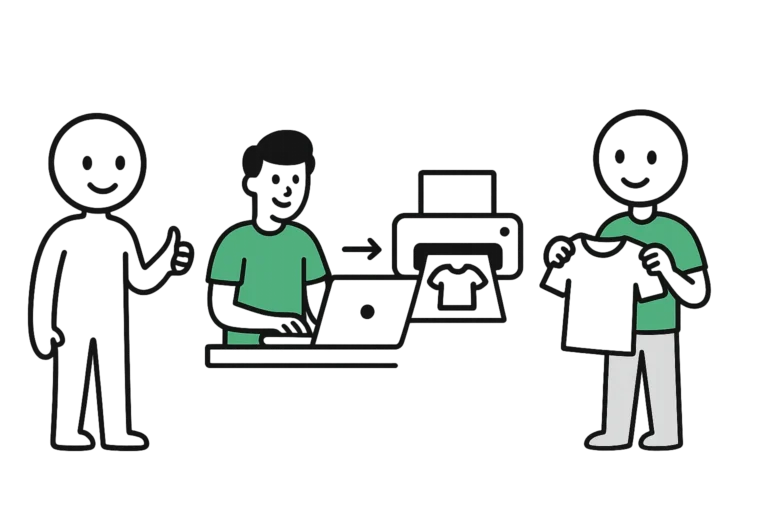
Print on Demand Statistics
Strong integration among eCommerce platforms, AI design systems, and eco-friendly printing methods has positioned this market at the forefront. The following statistics reflect the strength, consumer behaviour, product mix, and regional trends in the print on demand space.
1. Consumer Statistics
- Nearly 80% of consumer feedback indicates that they prefer companies that offer personalised, customised products, which is a major factor in the growth of the print on demand market.
- According to ZikAnalytics, around 40% of annual print on demand sales occur during festivals and holidays, so targeting those seasons with the right pricing and offers will be more effective for profit margins.
- More than 60% of orders are placed on mobile devices, indicating the growth of mobile commerce and reminding sellers how to target their customers.
2. Product Category Statistics
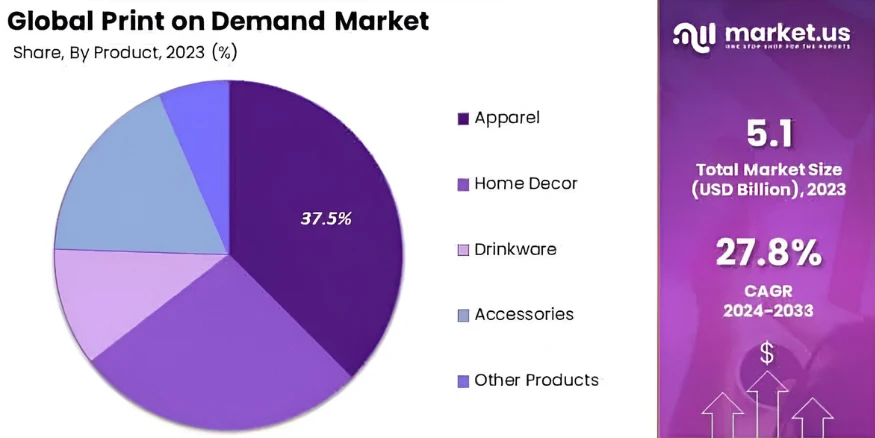
Source: Market-US
- Though software has a lead, apparel products currently dominate the print on demand market’s revenue share and are poised to take the lead in the coming years.
- Also, the apparel category has been identified as the fastest-growing segment of the print on demand market worldwide. It is estimated to grow by 27-28% or more in the coming years.
- Amid the growth of other product categories like home decor and lifestyle accessories, t-shirts lead the market, accounting for 60% of print on demand orders worldwide.
Though plain t-shirts have their own fanbase, custom-printed t-shirts are the market trend. This customisation culture drives higher engagement and willingness to buy, making personalised T-shirts a profitable segment within the broader market.
3. Regional & Platform Statistics
- North America is predicted to dominate the global market with revenue around 40%, followed by Europe and Asia-Pacific. Among them, the Asia-Pacific region is expected to expand its substantial revenue as a fast-growing market.
- In terms of platform usage, around 62% of all print on demand stores globally use or integrate the Shopify platform as their online store.
4. Business & Market Statistics
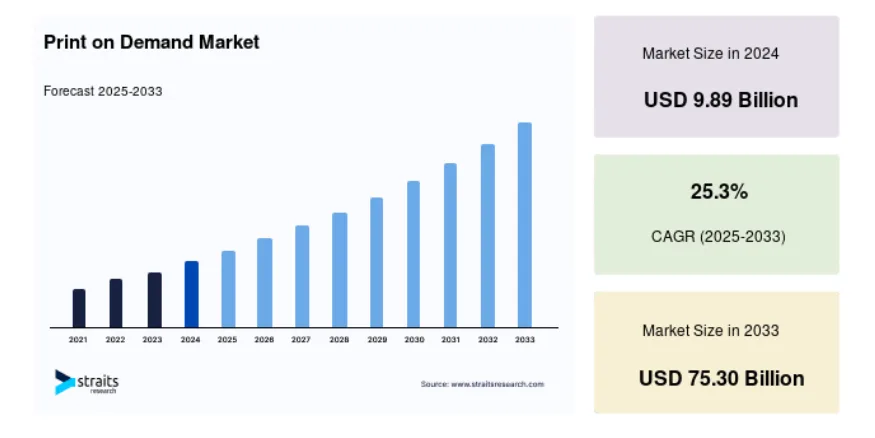
Source: StraitsResearch
- Various market research reports indicate that the global print on demand industry will experience a CAGR of approximately 23% to 28% over the next several years.
- The growth of print on demand stores was enabled by lower entry barriers, scalability, and the integration of AI-powered design tools and eCommerce platforms, which streamline operations for independent creators worldwide.
These print on demand stats make us understand that this is not just a passing cloud trend; rather, it will be a long-term business for sustainable income and will give your individuality a brand in the Print-on-Demand market.
Market Drivers for Print on Demand
The print on demand industry is thriving due to several powerful market drivers that align with evolving consumer preferences, technological innovation, and business needs. These factors not only boost market growth but also shape the competitive landscape, offering new opportunities for entrepreneurs and established brands.
Demand for Personalisation
Consumers increasingly expect unique, custom-made products rather than mass-produced items. Products like a t-shirt with a famous dialogue printed on it, wall art with a personal photo, or a mug with a meaningful quote are favoured at the top of the purchase list, underscoring the massive demand for customised products.
eCommerce & Retail Models
With the print on demand model, you don’t need to hold inventory upfront; you only print after you receive an order. The global consumers favouring online purchases means this model fits naturally into the digital retail era.
Additionally, integrating print on demand sites with global eCommerce platforms is a significant growth catalyst. For instance, platforms like Etsy now support print on demand fulfilment, indicating that this ease of integration is a key driver in the market.
Digital Printing Technology
The availability of Digital textile printing, Sublimation, Direct-to-Garment (DTG), and other on-demand print technologies has reduced unit costs and improved quality. A report by Dynamic Mockups suggests that Digital printing is projected to grow at a CAGR of 12.5% between 2025 and 2030, with Sublimation printing growing even faster at 16.8% CAGR.
Automation in fulfilment, with integrated dashboards and real-time ordering, can improve customer satisfaction, and this technology supports and encourages every micro-brand to be precise about order volumes at their initial stages.
Sustainability & Waste Reduction
Sustainability drives many customers towards print on demand products, as digital printing consumes significantly less water and energy than traditional methods. Resonates strongly with eco-conscious consumers who are increasingly integrating sustainability into their purchasing decisions.
Sustainable print on demand companies like Qikink emphasise sustainable production using recycled fabrics, eco-friendly inks, and zero-waste processes, and differentiate themselves from other fast-fashion or mass-manufacturing brands.
Expansion Beyond Apparel
The growth of the internet, eCommerce, and social selling in emerging markets opens new boundaries for upcoming brands. New product categories such as home decor, accessories, and lifestyle goods are gaining market share, elevating print-on-demand revenue and market growth.
Beyond the Basics: How to Print T Shirts? – Advanced Techniques

What is the Indian Market Value for Print-on-Demand?

The Indian print on demand market is a rapidly expanding industry offering significant opportunities for entrepreneurs and brands. According to Mobility Foresights, it is projected to grow from ₹539 billion in 2025 to ₹1.36 trillion by 2031, at a CAGR of 16.7% over the forecast period.
This growth can be assessed with key factors such as:
- Smartphone penetration, massive eCommerce growth, and a rise in personalised products and custom fashion lines are making print on demand more accessible.
- The rise in income of most families in India has led them to prefer personalised, sustainable products, especially a greater interest in smaller brands for their affordable prices and high-quality offerings.
- Increasing demand for diverse products and categories, including unique items like apparel, lifestyle products, and accessories.
- Regional fulfilment networks, logistics improvements, and increased awareness of eco-friendly products align perfectly with this business model.
- Technological advances in digital printing and automated manufacturing are reducing costs and lead times.
If the CAGR holds at 25-26%, the market would double every 3-4 years. By 2026, you could see the value crossing 87 billion in India. The rate estimates can vary slightly due to methodologies, but the rapid growth of India’s print on demand market is consistent.
Entering this industry in the Indian market as an entrepreneur, with the right strategies and key factors in mind, you have a genuine space and potential to grow into a competitive brand, with market size and revenue statistically increasing.
Print on Demand Success
Many print on demand sellers set target profit margins around 20% or slightly higher once their processes, such as design, fulfilment, and marketing, are running smoothly. Higher-quality products, better marketing, and repeat customers can push those margins to 30% to 40%.
This business model can lead to success because it keeps fixed costs low, allowing you to scale without the same risks as traditional manufacturing. A perfect print on demand business model should demonstrate its efforts in niche selection, design consistency, efficient fulfilment, and strong branding and customer experience.
What is the Success Rate of Print-on-Demand?

Based on industry and survey data, about 24% of print on demand stores survive for three or more years. In simpler terms, roughly 1 in 4 businesses could clear the line. The majority of those stores either stop or underperform before their targeted time.
This model is accessible, but success does not knock on your door without hard work and consistent effort. Execution matters a lot more than just launching a store. To create or improve your success rate in print on demand:
- Choose a niche and design that stands out, because stores that specialise in themes, such as minimal designs, travel apparel, regional art, or motivational quotes, build better engagement and repeat buyers.
- Don’t treat your business startup as a side business; instead, focus on operations, marketing, product updates, and repeat customers.
- With no inventory costs, see it as an advantage and invest in designs to deliver quality products, which can get you into the top-performing tier list.
- Be transparent and share your printing techniques and the inks you use to build customers’ trust and drive organic word-of-mouth marketing for your store.
- Automate the process and monitor your revenue flow and profit margin to scale your business accordingly.
Ultimately, success depends on how you implement the technology and tools at your disposal. Still, the success rate of the print on demand market in India has grown over the years, and revenue and profit margins have risen.
Try to focus on innovation, quality, and customer alignment, and prove that persistence is the real success factor in the print on demand world.
What Print on Demand Products to Sell?
After learning the statistics and factors, most upcoming entrepreneurs may have doubts about which top print on demand products to sell. We have already seen a variety of categories and products grow in the print on demand market. Let’s revise and break down those product categories.
1. Apparel
- T-shirts: T-shirts remain the most reliable product with a broad audience due to their versatility. The global custom t-shirt printing market is expected to reach more than $3.1 billion(₹273.9 billion) by 2026, indicating strong demand.
- Hoodies & Sweatshirts: These items are popular for their comfort and style, making them ideal for custom designs.
- Leggings & Activewear: With the rise of athleisure and the Dri-FIT trend, custom leggings and activewear are gaining popularity and attracting more customers.
2. Home Decor
- Wall Art: Custom prints, including posters and canvas art, are in high demand as consumers seek to personalise their living spaces.
- Pillows & Blankets: Personalised home textiles for cushions, pillows, and blankets that add a cosy, unique touch to home interiors.
- Mugs & Drinkware: Custom mugs and drinkware are popular for both personal use and gifting purposes.
3. Accessories
- Tote Bags & Backpacks: Functional and fashionable, the tote bags are sought after for their versatility and customisation options.
- Phone Cases: With smartphones worldwide, custom mobile cases will always remain a top-selling accessory.
- Jewellery: Personalised items, such as necklaces and bracelets, cater to consumers seeking unique, customised pieces.
4. Seasonal & Niche Products
- Holiday-Themed Items: Products related to festivals and other holiday themes, such as Diwali gifts, Christmas ornaments, and Valentine’s Day items, have higher demand during their respective seasons.
- Pet Products: Custom pet accessories, including pet tags and apparel, are loved by pet owners if customised.
Having diverse product categories will help increase your brand value faster than you expect. Also, ensure the product’s sustainability, as eco-conscious buyers are shifting towards ethically made products such as organic cotton apparel, reusable drinkware, and recycled-fabric tote bags.
Categorising the top print on demand products and producing them sustainably reflects a personalisation store that is environmentally responsible retail. Also, choosing emotionally appealing and functionally relevant products gives sellers the best chance of achieving scale and profitability in this modern, evolving print on demand ecosystem.
Future Outlook for the Print on Demand Market
The print on demand industry is experiencing continued growth, driven by rising demand for personalised, sustainable products and a growing eCommerce fanbase. As more consumers seek unique items, brands are adapting to meet their needs and to stay competitive.
Technological innovations, including AI-powered tools for design, automated fulfilment systems, and advanced digital printing, will make scaling your print on demand stores easier than ever. This will also make smaller brands visible in this vast market.
In India and other emerging regions, the growth of online retail and the boom in eCommerce are driving the adoption of print on demand. Local fulfilment networks and updated shipping operations will further support faster delivery and customer satisfaction.
Looking ahead, success in print on demand will increasingly depend on consistency. The next decade will see print on demand evolve into a permanent pillar of eCommerce infrastructure, driven by innovation and sustainability, so entrepreneurs who prioritise quality and eco-friendly products will likely capture the largest share of this growing market.
Build Your Brand with Qikink
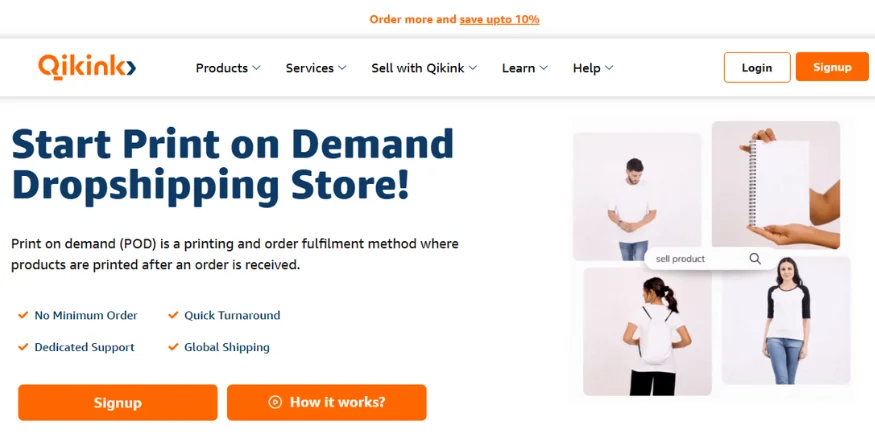
Print on demand is more than just a business model; it’s a powerful way to turn your creativity into a scalable brand with minimal risk. Whether you’re an independent artist, entrepreneur, or an established business looking to expand your product line, the opportunities have never been greater than now.
With the growth of personalisation, sustainability, and technology-driven fulfilment, now is the perfect time to launch or scale your print on demand brand. Then why wait? Start your brand with Qikink today.
Qikink offers seamless integration, eco-friendly printing options, and robust support, so you can focus on what matters most: your unique designs and customer relationships. Start building your dream brand by signing up today with Qikink, where your ideas come to life, and your business grows without limits.

Final Thoughts
The print on demand industry has evolved from a niche concept into a multi-billion-dollar market, driven by rapid growth in scale and revenue. Its scalability, low-risk model, and alignment with modern consumer trends make it a viable business for aspiring entrepreneurs and established brands alike.
By focusing on personalisation, sustainability, and technology integration, sellers can build a long-term, profitable business with minimal upfront investment. The industry’s long-term trajectory proves that customisation and eco-friendly production are not just trends but the foundation of a new retail era.
With global and Indian markets showing organic growth, it is an ideal time to explore the vast opportunities in print on demand. Choose the right niche, offer high-quality products, and launch your brand by joining Qikink and standing out in this competitive print on demand market.
Read More
Frequently Asked Questions
How big is the print-on-demand market?
The global print-on-demand market is estimated at ₹0.79–₹1.06 trillion in 2025, with a projected CAGR of 23.3% through 2033, potentially reaching ₹5.08 trillion. ECommerce expansion, personalised products, and technological innovations fuel this growth.
What is the scope of print-on-demand in India?
The Indian Print on Demand (POD) market is expected to grow from ₹539 billion in 2025 to ₹1.36 trillion by 2031 at a CAGR of 16.7%. Rising smartphone adoption, online shopping, and demand for customised, eco-friendly products are driving India to become one of the fastest-growing POD markets.
Which is the largest printing company in India?
Qikink is among the leading print-on-demand companies in India, providing integrated fulfilment services, custom printing, and sustainable product options for entrepreneurs and brands nationwide.
What are the key factors driving the revenue growth of the Print on Demand business?
The primary growth drivers of the print-on-demand market value include increasing internet penetration, smartphone adoption, and the growing number of online shoppers. Technological developments and numerous extensive textile facilities are projected to help the regional market grow.
How does the revenue of the Print on Demand industry compare to traditional printing methods?
Traditional and digital printing presses differ in several ways. Digital printing presses can print on a variety of surfaces without the use of printing plates. Digital printing is a more efficient and cost-effective way of printing. The majority of consumer printers are now digital printers. Hence, print-on-demand is more profitable compared to traditional printing.

